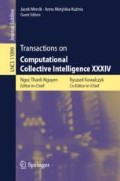Abstract
Most electoral reforms are dictated by recognized problems discovered in the existing procedures or - perhaps more often - by an attempt to consolidate power distributions. Very rarely, if ever, is the motivation derived from the social choice theory even though it deals with issues pertaining to what is possible and what is impossible to achieve by using given procedures in general. We discuss some reforms focusing particularly on a relatively recent one proposed by Eric Maskin and Amartya Sen. It differs from many of its predecessors in invoking social choice considerations in proposing a new system of electing representatives. At the same time it exemplifies the tradeoffs involved in abandoning existing systems and adopting new ones.
The author thanks the referees for numerous constructive comments.
Access this chapter
Tax calculation will be finalised at checkout
Purchases are for personal use only
Notes
- 1.
It is relatively straightforward to see how this conclusion is derived. To wit, suppose that there is a Condorcet loser, say x, in a profile consisting of n voters and k alternatives. This means that in each pairwise comparison, the maximum number of votes for x is strictly less than n/2. Hence x’s Borda score is less than \((k-1)\times (n/2)\). If all alternatives had the same or smaller Borda score than x (which would make x the Borda winner), the total number of Borda scores would be no larger than: \(k\times (k-1)\times n/2 \). Now this upper bound is strictly less than the sum total of Borda scores in any profile, viz. \( n \times (k^{2} - k)/2 = k \times (k-1) \times n/2\). (The number of pairwise comparisons involving different alternatives is \(k^2 - k\) with the sum of entry (i, j) and entry (j, i) being equal to the number of voters, n, for all alternatives i and j.) Therefore, in any profile there must be at least one alternative with a strictly larger Borda score than that of the Condorcet loser. Hence, the latter cannot be elected by the Borda count.
- 2.
A strong Condorcet winner is an alternative ranked first by more than half of the electorate. Obviously, all procedures that elect a Condorcet winner also elect a strong Condorcet winner. The converse is not true, that is, there are procedures (e.g. plurality voting) that elect the strong Condorcet winner, but not necessarily a Condorcet winner.
- 3.
Nanson’s argument to that effect is pretty similar to the one in footnote 1. It amounts to showing that the lower bound of the Borda score of a Condorcet winner is strictly larger than the average of the Borda scores.
- 4.
- 5.
For example, let a three-person four-alternative profile be the following: 1 voter: ABCD, 1 voter: CBDA, 1 voter: DBAC. Here B is the Condorcet winner.
- 6.
- 7.
- 8.
For a related discussion on the MS procedure, see [18].
References
Baldwin, J.M.: The technique of the Nanson preferential majority system. Proc. Roy. Soc. Victoria 39, 42–52 (1926)
Black, D.: On the rationale of group decision-making. J. Polit. Econ. 56, 23–34 (1948)
Brandt, F., Geist, C., Peters, D.: Optimal bounds for the no show paradox via SAT solving. Math. Soc. Sci. 90, 18–27 (2017)
De Grazia, A.: Mathematical derivation of an election system. Isis 44, 42–51 (1953)
Felsenthal, D.S., Machover, M.: After two centuries should Condorcet’s voting procedure be implemented? Behav. Sci. 37, 250–273 (1992)
Felsenthal, D.S., Nurmi, H.: Monotonicity Failures Afflicting Procedures for Electing a Single Candidate. Springer, Cham (2017). https://doi.org/10.1007/978-3-319-51061-3
Felsenthal, D.S., Nurmi, H.: Monotonicity violations by Borda’s elimination and Nanson’s rules: a comparison. Group Decis. Negot. 27(2018), 637–664 (2018)
Felsenthal, D.S., Nurmi, H.: Voting Procedures Under a Restricted Domain. An Examination of the (In)Vulnerability of 20 Voting Procedures to Five Main Paradoxes. Springer, Cham (2019). https://doi.org/10.1007/978-3-030-12627-8
Fishburn, P.C., Brams, S.J.: Paradoxes of preferential voting. Math. Mag. 56, 207–214 (1983)
Maskin, E., Sen, A.K.: How majority rule might have stopped Donald Trump. The New York Times, 28 April 2016 (2016). https://www.nytimes.com/2016/05/01/opinion/sunday/how-majority-rule-might-have-stopped-donald-trump.html
McLean, I., Urken, A.B.: Classics of Social Choice. University of Michigan Press, Ann Arbor (1995)
Moulin, H.: Condorcet’s principle implies the no-show paradox. J. Econ. Theory 45, 53–64 (1988)
Nanson, E.J.: Methods of elections. Trans. Proc. Roy. Soc. Victoria 19, 197–240 (1883). McLean, I., Urken, A.B. (eds.) Classics of Social Choice, Chapter 14, pp. 321–359. University of Michigan Press (1995)
Niou, E.M.S.: A note on Nanson’s rule. Public Choice 54, 191–193 (1987)
Nurmi, H.: On Nanson’s method. In: Borg, O., Apunen, O., Hakovirta, H., Paastela, J. (eds.) Democracy in the Modern World. Essays for Tatu Vanhanen, series A, vol. 260, pp. 199–210. Acta Universitatis Tamperensis, Tampere (1989)
Nurmi, H.: Voting Paradoxes and How to Deal with Them. Springer, Heidelberg (1999). https://doi.org/10.1007/978-3-662-03782-9
Nurmi, H.: Reflections on two old Condorcet extensions. Trans. Comput. Collective Intell. XXXI, 9–21 (2018)
Nurmi, H.: Voting theory: cui bono? Politeia 91, 106–121 (2018)
Pérez, J.: The strong no show paradoxes are a common flaw in Condorcet voting correspondences. Soc. Choice Welfare 18, 601–616 (2001)
Saari, D.G.: Capturing ‘The Will of the People’. Ethics 113, 333–349 (2003)
Author information
Authors and Affiliations
Corresponding author
Editor information
Editors and Affiliations
Rights and permissions
Copyright information
© 2019 Springer-Verlag GmbH Germany, part of Springer Nature
About this chapter
Cite this chapter
Nurmi, H. (2019). Electoral Reform and Social Choice Theory: Piecemeal Engineering and Selective Memory. In: Nguyen, N., Kowalczyk, R., Mercik, J., Motylska-Kuźma, A. (eds) Transactions on Computational Collective Intelligence XXXIV. Lecture Notes in Computer Science(), vol 11890. Springer, Berlin, Heidelberg. https://doi.org/10.1007/978-3-662-60555-4_5
Download citation
DOI: https://doi.org/10.1007/978-3-662-60555-4_5
Published:
Publisher Name: Springer, Berlin, Heidelberg
Print ISBN: 978-3-662-60554-7
Online ISBN: 978-3-662-60555-4
eBook Packages: Computer ScienceComputer Science (R0)

